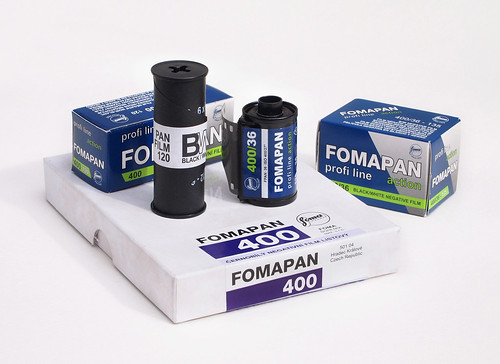 |
| Fomapan 400 in 35mm, medium format 120 and large format sheet film |
Having spent some time testing Foma's new film,
Retropan 320, earlier this year, I thought I should also look in a little more detail at
Fomapan 400, which I'd used in 9x12cm size sheet film with the
Recomar 33, and also shot some in medium format while in
Stockholm. I'd first used Fomapan 400 six or seven years ago, shortly after I'd started developing black and white films again after a gap of a few years. The attraction of Fomapan 400 was its price, at that time it was less than £3 a roll in medium format. I tried it in both medium format and 35mm: I didn't like the results of Fomapan 400 in 35mm very much, so I didn't use it again, but I did continue to use it periodically in medium format.
Foma's
own reference sheet states that:
FOMAPAN 400 Action is a panchromatically sensitized, black-and-white negative
film designed for taking photographs under unfavourable light conditions or using
short exposure times. The film meets high requirements for low granularity, good
resolving power and good contour sharpness. FOMAPAN 400 Action has a nominal
speed rating of ISO 400/27º, but due to its wide exposure latitude the film gives
good results even when overexposed by 1 EV (exposure value) (as ISO 200/24º)
or underexposed by 2 EV (as ISO 1600/33º) without any change in processing, i.e.
without lengthening the development time or increasing the temperature of the
developer used.
Foma's films have suffixes for each different speed: Fomapan 400's designation is 'Action' (although this isn't used on the large format packaging). These suffixes 'Action', 'Creative' (Fomapan 200) and 'Classic' (Fomapan 100), now joined by 'Soft' (Retropan 320), don't appear to be used by photographers shooting these films, although I suppose they do function as being a little more descriptive than the nominal film speed rating. Having only used Fompan 400 in medium and large format for a few years, I thought it would be worth shooting 35mm again to make a series of tests for this blog post. Using the smaller format more clearly shows the film's characteristics in terms of grain, which was what I initially disliked about the film. As with other films, I shot a latitude test, partly due to the claims Foma makes for the film; having used the film for a number of years, I was sceptical about the wide latitude described on the data sheet as quoted above.
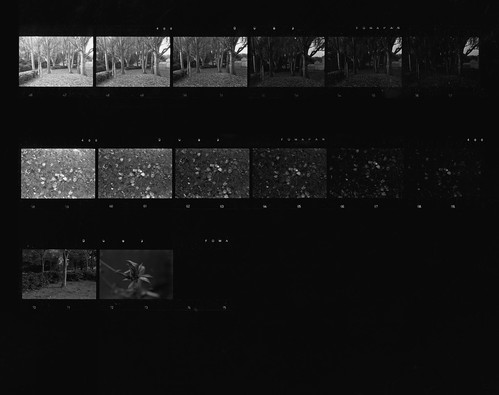 |
| Fomapan 400 latitude test with R09 One Shot |
The first two rows on the contact sheet above were shot with successive frames rated 50, 100, 200, 400, 800, and 1600 (both frames in the third row were rated 400). The film was developed in R09 One Shot, diluted 1+25 for 6 minutes at 20ºC. Rodinal/R09 One Shot is the main developer I use; in the past, I've read online about Rodinal not giving true box speed, especially with faster emulsions, but this isn't something that's apparent with many films. However, this may be the case with Fomapan 400: the data sheet states that the film can be underexposed by two stops "without any change in processing", but the test above shows very little shadow detail at 800, and little shadow
and mid-tone detail at 1600, two stops under. The best negatives of the test were probably those rated at 200, while those at box speed appear thin. (The
400 ISO film comparison on digitaltruth.com appears to show Fomapan 400 performing worst in terms of latitude out of the five films tested, confirming the results from my own test).
I shot a second latitude test in 35mm again, but used a different developer, Ilfotec LC29, diluted 1+29 for 9 minutes at 20ºC, to compare the results against the test developed in R09. This test appears to show better latitude with the film; the strips below were exposed as in the first test, with successive frames rated 50, 100, 200, 400, 800, and 1600.
 |
| Fomapan 400 latitude test with Ilfotec LC29 |
This test, although scanned and therefore not a direct comparison with the contact sheet of the first test does appear to show much better latitude, although there is still a lack of shadow detail in the frames two stops underexposed.
Although Foma do not give recommendations for pushing the film, there are times and dilutions for pushing Fomapan 400 up to 3200 on the
Massive Dev Chart. Rating the film at 800, I used the Massive Dev Chart timing and dilution of 19 minutes at 1+50 with R09 One Shot (the chart does not provide data for pushing the film with Ilfotec LC29).
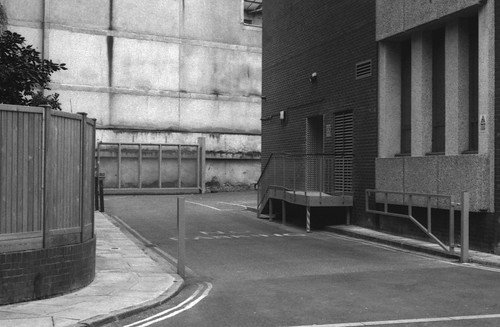 |
| Fomapan 400 at 800 in R09 One Shot |
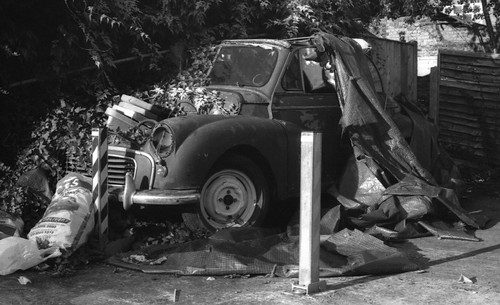 |
| Fomapan 400 at 800 in R09 One Shot |
The results with a one-stop push in R09 One Shot were fairly encouraging, but most were shot in good lighting conditions: the photographs in fairly bright but flat lighting were easier to scan, while those with sunlight had the raised contrast typical of push processing. Some of the images appear to show a small amount of halation, or possibly irradiation, visible with the foreground post in the shot above. I then exposed a roll of the film at 1600, again with the Massive Dev Chart's dilutions and timings of 1+50 for 24 minutes.
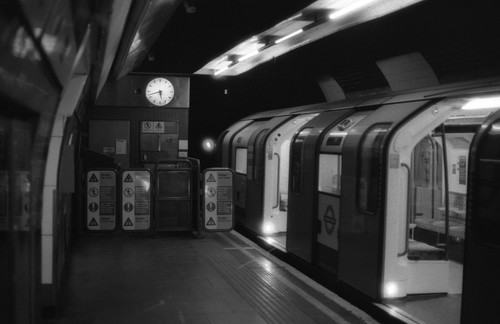 |
| Fomapan 400 at 1600 in R09 One Shot |
Some of these frames were shot in more challenging light conditions, such as the sort of low-light scenes where pushing two stops might be necessary for hand-held photography, and the results were better than expected, although in the scanning of the negatives I did have to pay a little more attention to pulling out shadow detail. The grain did not become too pronounced, although I find Fomapan 400 to look quite 'soft' and it appears to have a less uniform distribution than other fast films, the pattern of grain clumps being what gives it a distinct look.
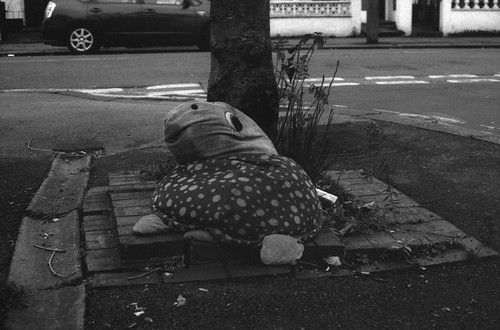 |
| Fomapan 400 at 3200 in R09 One Shot |
The Massive Dev Chart also had entries for a three stop push to 3200, with timings for both 1+25 and 1+50. I shot a roll of Fomapan 400 at 3200 and developed this in R09 One Shot, diluted 1+25 for 25 minutes at 20ºC; this entry has the note "high contrast" attached, but the time for 1+50 was 52 minutes, which was far too long to contemplate. At 3200 the negatives were extremely thin, most showing nothing other than highlights, with the above shot being the only frame worth scanning. After my results with the latitude test however, I did also want to try push-processing in Ilfotec LC29. With there being no times listed for push processing with this developer, I estimated, using as a starting point the fact that Fomapan 400's timings are very similar to
HP5 Plus. I diluted Ilfotec LC29 to 1+9 and developed for 12 minutes at 20ºC. The results, although perhaps better than R09 One Shot, were generally thin and lacking in any shadow detail, leaving the conclusion that for Fomapan 400, rating it at 3200 is a push of one stop too far. In addition, the longer times with R09 One Shot also appeared to show increased fog - something that increasing these times even further would exacerbate.
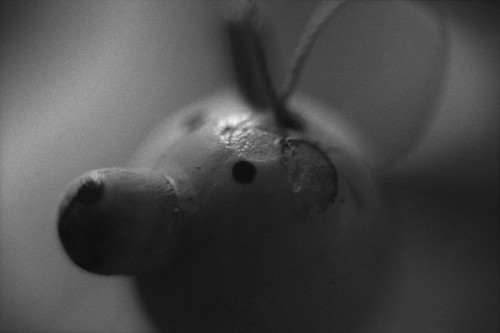 |
| Fomapan 400 at 3200 in Ilfotec LC29 |
Fomapan 400 would not be my first choice for 35mm film in the high speed range, although the results of my recent tests were better than I remember. I've been more likely to use it in medium format, which I have done off and on over the last few years, although I've found its lack of latitude to be less than ideal when
shooting with box cameras with limited or no controls over exposure; other films have been better for those purposes. However, Fomapan 400's qualities as a traditional emulsion do come across in medium format, and I most recently shot some in Stockholm with one of my flea market finds there, the
Agfa Isolette III.
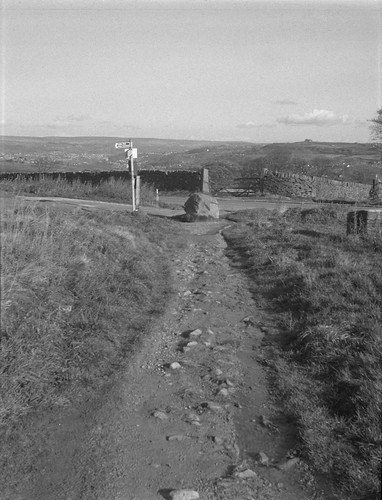 |
| Plaubel Roll-Op (6x4.5), Fomapan 400, Rodinal 1+25 |
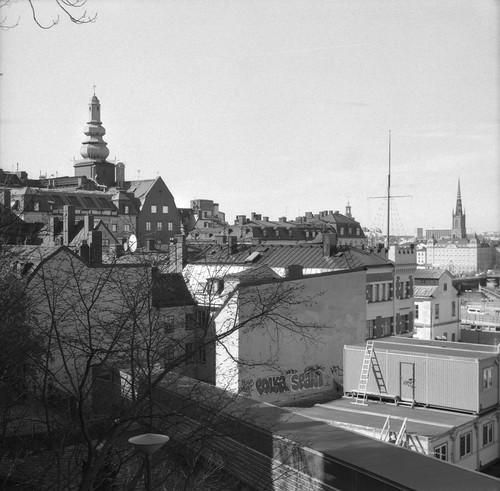 |
| Agfa Isolette III (6x6), Fomapan 400, R09 One Shot 1+25, 8min 20ºC |
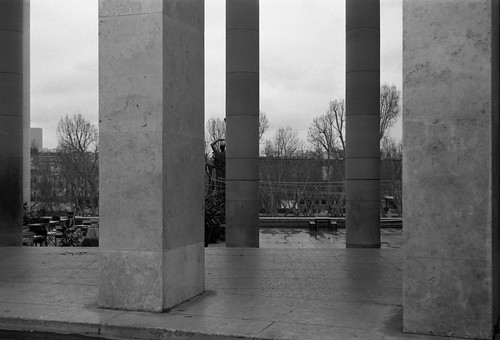 |
| Zodel Baldalux (6x9), Fomapan 400, Rodinal 1+50, 12m15s at 19º C. |
Where Fomapan 400 really shines is in large format: any reservations about the film's grain or latitude evaporate once price is taken into consideration: it's around half the price of HP5 Plus per sheet and less than a third of the price of Kodak Tri-X, and it's still relatively easy to find 4x5 Fomapan 400 in the UK. In 35mm and medium format the price differences aren't as magnified. Shooting large format with the
MPP Micro-Technical, I always use a tripod, which inevitably slows down the process of taking photographs, and I've learnt to rate the film at 320 or 250 ISO (see, for example, the shots in last year's post under
Old Lenses); additionally, shooting large format can be more forgiving. In contrast, I've tended to shoot my 9x12cm cameras hand held: as a European manufacturer, Foma's films are all readily available in the 9x12cm format. Even with the increased postage cost of buying the film from Europe, it's still cheaper per sheet than its competitors. On a final note, both examples of large format shots below are also taken with yellow filters.
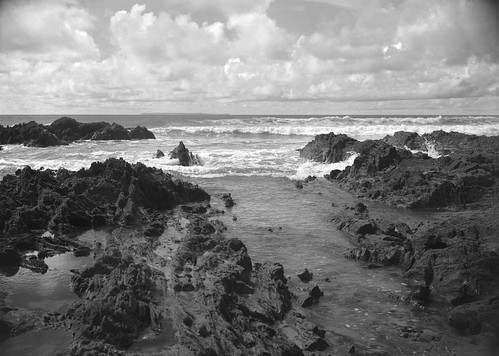 |
| Kodak Recomar 33 (9x12cm), Fomapan 400, rated 320, developed in Ilfotec LC29 1+29 for 9m |
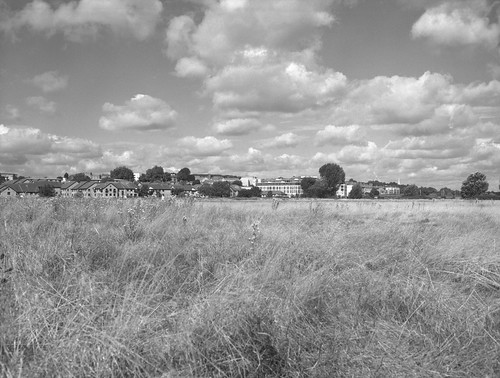 |
| MPP Micro-Technical (4x5), 150mm Xenar, rated 250, developed in Ilfotec LC29, 1+29 for 9m |














Hey Nick,
ReplyDeleteA very interesting article and perfectly timed as I've just shot some of my Canada pinhole work on Fomapan 400. I used it for some night photography that I need to push by a stop. After reading this blog post I'm more confident that it will work ok. I'll let you know how they turn out. Keep up the good work.
Anthony
p.s. what would we do without you Nick?
ReplyDeleteI can´t believe you got so fine grain in 135 mm shots. I pushed Agfa APX400 to 800 and develped in Rodinal 1+50 and I got huge grain. I scanned on Plustek Opticfilm 8100. APX400 is low cost film, like Fomapan 400. But when I see this, I am really suprised.
ReplyDeleteThanks for your comments - the appearance of grain does depend on a number of factors. With fast films and Ordinal I am careful not to agitate too vigorously - a couple of gentle inversions each minute, and making sure the temperature isn't above 20º. It also depends on the subject in the image, contrast detail and so on, and scanner settings too - I always turn off 'unsharp mask' as this usually looks terrible. I haven't tried APX 400 at 800 (I don't think); Fomapan 400 is grainy, but the grain has a 'softness' to it as well as a fairly distinct pattern, to my eyes anyway, which also helps I think.
Delete